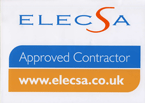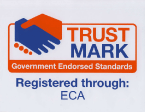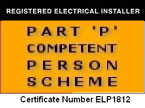Solar-Power.
Solar Power.

Solar Power Projects
Installation of Solar Power is only one of the services we offer as part of our Green Energy options.
We project manage the whole installation for you, from design of the system though to commissioning and testing.
If you have a desire to make your Home or Business more eco friendly, then we can help. Call us and we can talk about your requirements.
When you first have the idea to go green, how do you make this come true.
Case Electrical Services can take your ideas and make them a reality.
With our Solar and Wind packages,
We will Project Manage all aspects, from the Design to Installation and Completion.
- Integrations of the collecting devices,
- the connection to your home or business.
- We can connect you to the National Grid to sell back the excess energy you produce.
Grants are available from the government to install renewable energy systems.
Wind power and solar power are complementary in the sense that when a wind
resource is not available, sunshine often is. If both resources are available, then a hybrid system is the more economical approach. A hybrid system uses fewer batteries and the battery bank is cycled less, which results in longer battery lifetimes and lower costs.
Top
Renewable energy systems
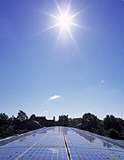
A renewable energy system converts the energy found in sunlight, wind, falling water, waves, geothermal heat, or biomass into a form we can use, such as heat or electricity. Historically, renewable energy was used exclusively as man's energy source until coal was first used in the 13th century, oil in the end of the 19th century and uranium in the middle of the 20th century.
Using renewable sources of energy promotes sustainable living and, except for burning biomass, is virtually pollution free.
Why Go Solar ?
Global climate change and the need to reduce carbon dioxide emissions, ever increasing energy bills.
All of these play an increasingly important role in the management of any building’s energy use. With energy efficiency high on the list of achievable improvements, the inclusion of a solar PV system goes further and can help transform a building from being an energy consumer to being an energy generator.
Solar is suitable for use in both urban and rural locations and is adaptable to almost any building which has sufficient exposure to light.
The value of solar electricity
There are financial advantages to installing solar PV, these include: avoided imported electricity costs, selling your electricity to energy suppliers and Renewable Obligation Certificates (ROCs). The amount of revenue you can generate is linked to the size of the system installed and its performance.
Renewable Obligation Certificates
Under the Renewables Obligation Order 2002, small generators of electricity are entitled to Renewable Obligation Certificates (ROCs) which the generator has the option to trade with their energy supplier. The ability to receive ROCs can lead to additional income for the generator.
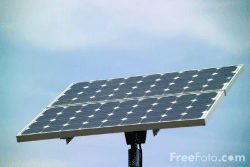
A 5kW system could generate 3-4 ROC’s per year. ROCs are certificates for the total generation of the PV roof, not just for the exported electricity.
One ROC is equivalent to approximately 1,000 kilowatt hours (kWh) of renewable electricity. ROCs are registered by the energy regulator OFGEM. In order to sell them, you need to register as an electricity generator and complete the relevant paperwork. Rates paid will differ every year. Please note, the income from ROCs may be greater than the amount you get by selling your electricity.
Offset your carbon dioxide emissions
As building regulations become more stringent, emphasising requirements for reduced carbon dioxide emissions from buildings, a correctly and appropriately installed solar PV system can provide an effective solution; for every 1kWh of electricity generated, 0.43 kilograms of carbon dioxide is offset. Additionally, for every 1 kilowatt peak (kWp) of PV installed, annual carbon dioxide emissions could be reduced by as much as 0.33 tonnes.
Benefits summary:
General Benefits.
- Generates clean, inflation proof electricity.
- Could increase the value of your development.
Business Benefits.
- Differentiates yourself from your competitors - creates an environmental brand name
- Meets corporate social responsibility (CSR) requirements.
- Increases stakeholder confidence in your investments.
Solar Photovoltaic (PV) technology is a smart building material
which converts light directly into electricity.
It is highly adaptable and integrates easily into any new or existing building
design as a roofing or cladding material or mounted as a framed energy
station.
Once installed in a location with good access to light, it increases a
building’s energy efficiency rating and generates green electricity without the
carbon dioxide emissions that contribute to climate change.
On-site electricity
generation avoids most transmission losses, ensuring the full benefit is
delivered directly to the building. With little or no maintenance costs, a solar
PV system will reliably contribute electricity to a building’s overall energy
requirements.
What is a solar PV system?
A solar PV system is an energy system which directly converts energy harnessed
from the sun into electricity. This electricity is used throughout a building in the
same way as conventional electricity imported from the grid.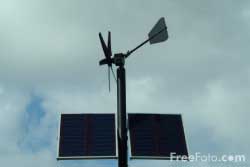
How does it work?
Silicon material is at the core of most solar PV technology. Once light hits the
silicon, electricity is generated and fed through a cable to be collected at an
inverter. The inverter converts the Direct Current (DC) to Alternating Current
(AC) before feeding it into the building’s main electrical circuit. The electricity
generated by the system works hand in hand with the existing electrical supply
sharing the same circuitry and wiring.
Top
A Basic Overview
 This Diagram shows how the main components of a Solar Power System are connected together.
This Diagram shows how the main components of a Solar Power System are connected together.
Power Invertors
The inverter is an essential component of a renewable energy system for delivering household electricity from a DC source. The inverter converts direct current (DC), either stored in batteries or directly from the solar array, into household alternating current (AC)
There are several types of power inverters. These are broken down into two main categories.
True Sine Wave Power Inverters
These true sine wave power inverters provide utility grade power. These inverters are expensive, although prices are continually falling. These true or pure sine wave power inverters can power almost anything including laser printers and fax machines. A sine wave inverter is designed to replicate and even improve the quality of electricity supplied by utility companies. To operate higher-end electronic equipment, a sine wave inverter is recommended.
Modified Sine Wave Power Inverters
Modified sine waves are the most common types of power inverters. A modified sine wave inverter can adequately power most household appliances and power tools. It is more economical, but may present certain compromises with some loads such as microwave ovens, laser printers, clocks and cordless tool chargers.
Top
Change Over Switches
This is how you connect your buildings electrical systems to either the solar collected electrical energy or the normal electricity supplied by your utility provider.
These can be either manual change over or Automatic change over.
Top
Grid Connections
Connecting to the National Grid, allows you as an electricity provider to sell electricity back to the National Grid.
these connections will have metres to monitor the electricity used or supplied.
Top
